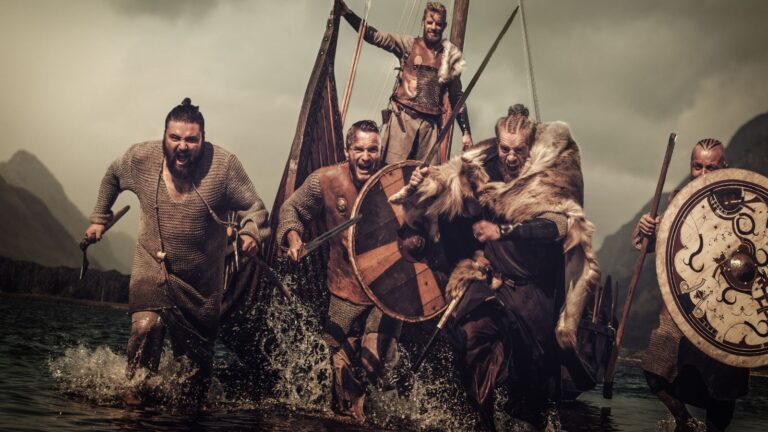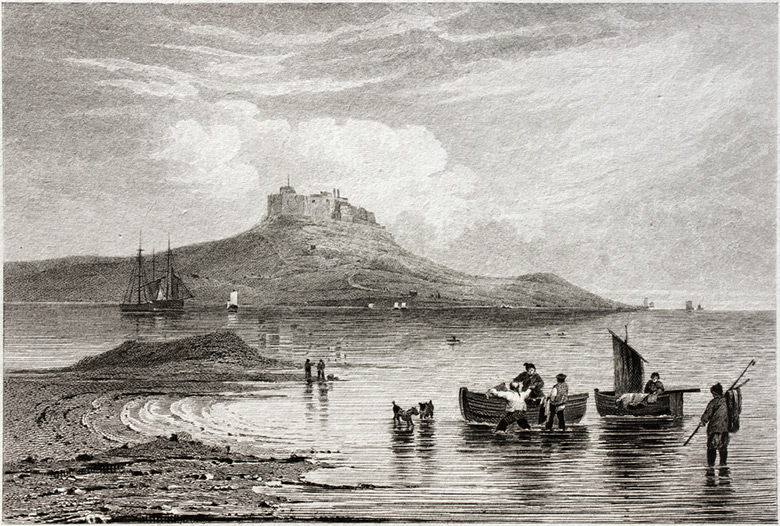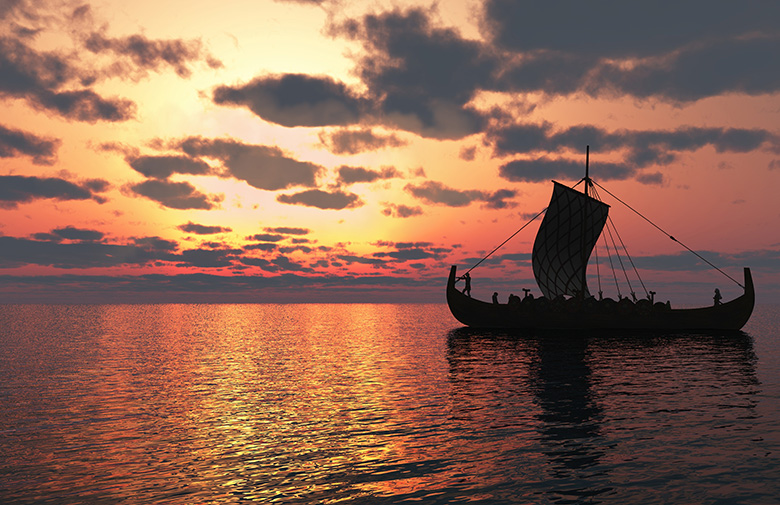The northmen's unexpected, vicious attack on the monastery at Lindisfarne in 793 is widely regarded as the beginning of the Viking Age. Here is the story of the Lindisfarne raid and what followed.
I first heard about the raid on Lindisfarne in primary school. For whatever reason, the image of longships crossing the sea to attack distant lands stayed with me for years. It fired my imagination and sparked an early interest in history.

Now that I live in Scandinavia, I’ve come to understand just how significant that event really was. Not just for the British Isles, but for the whole of Europe.
Although it wasn’t the first Viking encounter in Britain, the Lindisfarne raid had a far greater impact than anything that came before. It transformed the image of the northmen and marked the beginning of a new, violent chapter in European history.
Table of Contents
What the Sources Say
Despite their famous runestones, the Vikings left behind very few written records. Their stories were passed down orally for generations and only written down centuries later in the Icelandic sagas.
But when it comes to Lindisfarne, we’re lucky. We do have some contemporary written sources—though they come from the English side.
These include an entry in the Anglo-Saxon Chronicle and a vivid letter written by the Northumbrian monk Alcuin to Bishop Higbald, who had written to him in the immediate aftermath of the raid. Sadly, Higbald’s letter has been lost.
Thanks to these records, we know far more about the Lindisfarne raid than most other Viking attacks. What follows is a summary of what happened—and why it mattered so much.
Before the Raid
Although the Lindisfarne raid is remembered as the beginning of the Viking Age, it wasn’t the first time the British Isles had encountered seaborne raiders from the north. The Anglo-Saxon Chronicle describes an earlier incident in 787:
“In this year came first three ships of the Northmen from the land of robbers… The reeve rode to meet them and tried to bring them to the king’s town, for he did not know what they were. He was killed. These were the first ships of the Danish men that sought the land of the English nation.”

This short passage hints at how unfamiliar these visitors were at the time. The local official didn’t recognise them as a threat until it was too late. These early raids were small in scale, likely reconnaissance missions or opportunistic plundering, but they were a sign of what was to come.
At the same time, the British Isles were politically fragmented. England was not yet unified but divided into rival kingdoms like Northumbria, Mercia, and Wessex. These kingdoms often fought among themselves, leaving coastlines and monasteries poorly defended.
Monasteries in particular made tempting targets: they held gold and silver objects, food stores, and manuscripts, yet they were often isolated and lacked fortifications.
Lindisfarne, situated on a tidal island off the coast of Northumbria, was a perfect example. It was a symbol of Christian power and wealth, yet geographically exposed. While no one could have predicted the scale of violence that would descend on the island in 793, the vulnerabilities were already there.
In hindsight, the warning signs were clear. The small raid in 787, combined with the growing use of longships and increased seafaring in Scandinavia, suggested that something new was brewing in the north.
But when the longships finally arrived at Lindisfarne, the scale and savagery of the attack caught everyone by surprise, and marked the beginning of a new era.
Why Lindisfarne Mattered
Founded in the mid-7th century, the monastery and bishopric at Lindisfarne became a centre of Christian learning and missionary work. It was home to some of the most influential figures in early British Christianity, including St. Cuthbert, who was made bishop in 685.
After Cuthbert’s death, reports of miracles at his shrine turned Lindisfarne into a major pilgrimage site. With that spiritual importance came wealth. By the end of the 8th century, Lindisfarne likely held a great many treasures—gold, silver, manuscripts, and valuable religious objects.

The island was often referred to as “the Holy Island,” and the scholar Alcuin later described it as “a place more sacred than any in Britain.” That made its destruction even more devastating.
Where Did the Viking Raiders Come From?
The Anglo-Saxon Chronicle refers to the attackers as “Danish men,” but that label doesn’t necessarily tell us their true origin. In early medieval sources, “Dane” was often used as a broad term for all raiders from across the North Sea. It didn’t always refer specifically to people from the region we now know as Denmark.
As one Viking researcher explained to me on the Life in Norway Show, it was a bit like calling all foreign invaders “Romans” long after the empire had collapsed. It was convenient shorthand rather than a precise identity.
Historians now believe that earlier Viking raids on the British Isles, including the small attack recorded in 787, may well have originated in southern Scandinavia. These regions are closer to the English coast and would have been more accessible to seafarers making shorter exploratory trips across the North Sea.
But Lindisfarne was different. It marked a significant escalation, both in distance and in impact. Some scholars believe the 793 raid may have come from farther north, along the rugged western coast of what is now Norway.
Supporting this theory is a striking phrase in a letter written shortly after the raid by Alcuin, an English monk and scholar. He described the attack as “a voyage not thought possible,” suggesting that the origin of the longships had defied expectations.
This line is crucial. By 793, the presence of raiders from Denmark in England was already known. If the attackers had simply come from the same direction as before, their arrival might not have caused such astonishment.
Alcuin’s reaction implies that the raiders crossed a much longer and less predictable route, likely from fjords and settlements on the Norwegian coastline.
The Norwegians of the time had a strong seafaring culture, born from their geography: a mountainous landscape broken by deep fjords and with poor overland infrastructure. Sailing, not walking, was the fastest way to travel.
Over time, they developed highly efficient longships capable of withstanding ocean crossings and navigating shallow rivers.
By the late 8th century, Norwegian sailors had both the technology and the motivation to push their horizons westward. While we may never know with certainty exactly where the attackers came from, the evidence points toward western Norway as a strong possibility.
The Attack on Lindisfarne
The Anglo-Saxon Chronicle entry for 793 reads:
“Here terrible portents came about over the land of Northumbria, and miserably frightened the people: these were frequent flashes of lightning, and fiery dragons were seen flying in the air. A great famine immediately followed these signs, and a little after that in the same year on 8 January the raiding of heathen men miserably devastated God’s church in Lindisfarne island by looting and slaughter.”

Although the Chronicle gives the date as 8 January, modern historians generally agree the raid happened in June. Stormy weather or a gloomy sky is often suggested, helping the ships avoid detection.
Recent research has shown that approaching longships could have been seen from Lindisfarne with up to an hour’s warning. But the monks were completely unprepared. Despite earlier incidents, it seems the idea of a large-scale, violent raid on a religious site still seemed unthinkable.
The attackers looted the monastery, stole valuables, and killed many of the monks. The accounts we have are brief, but the emotional language speaks volumes. In his reply to Bishop Higbald, Alcuin described the attack as “an unprecedented calamity” and wrote:
“The church of St Cuthbert is spattered with the blood of the priests of God, despoiled of all its ornaments. The pagans trample on the bodies of saints in the temple of God, like dung in the street.”
It’s clear that this was no ordinary act of war—it was a shocking violation of what was considered sacred.
The Lasting Legacy of the Lindisfarne Raid
The raid on Lindisfarne sent shockwaves through the Christian world. News of the attack spread quickly, and the brutality of the violence, especially the desecration of one of Britain’s holiest sites, marked a turning point in European history.
From this moment on, the image of the northmen shifted from distant traders to a real and terrifying threat.
Before 793, Viking visits to the British Isles were rare and often dismissed as isolated incidents. But Lindisfarne shattered any sense of security. The idea that a sacred monastery could be so easily overrun by pagan raiders stunned both Anglo-Saxon England and the wider Christian world.
Some even saw it as divine punishment, with chroniclers describing omens in the sky and interpreting the raid as a sign of God’s anger.
Lindisfarne became a symbol of this new age of fear. Over the coming decades, similar raids would sweep across Britain, Ireland, and the coasts of mainland Europe, but it was the attack on Holy Island that stood out, remembered as the moment the Viking Age truly began.
Despite this dark legacy, Lindisfarne remained a place of pilgrimage. The cult of St. Cuthbert endured, and the monks eventually carried his remains inland to what would become Durham Cathedral.
Today, Lindisfarne attracts both spiritual pilgrims and history enthusiasts. The ruins of the priory and the 16th-century castle continue to tell the island’s story.
Occasional events mark the raid, which has been imagined, reimagined and immortalised in many TV shows and movies over the years.
In 2020, the discovery of a rare Viking board game piece buried on the island raised new questions. Was it left behind by one of the raiders?
We’ll never know, but it’s a fitting reminder of how the mystery and memory of Lindisfarne still captivate us more than 1,200 years later.



It seems most probable that the Northmen knew of the location as a poorly defended place of valuables. How that information came to them is a mystery.
The norse had been travelling back and fire between UK and Scandinavia since at least the 1st century ad and probably a lot earlier than that.
What I do find curious is that the first monasteries attacked were all Celtic and not Roman.
Seems to me very much a case of a false flag operation carried out by or at the behest of Roman Christians
Rome was always into power and control by hook or by crook, aye? They had false flags back then?! Some things never change…
Viking blood left some interesting DNA in other lands.
Interesting point of view…since I believe definitely that the ‘Norman Conquest of England’ was a plot by the Vatican… as were other wars…like those waged against Constantinople by the Normans…they also targeted the Celtic Christian religion in favor of ‘Latin based Christianity’…I (having Celtic blood) would like more information on what happened to Celtic catholisism and what did it stand for?